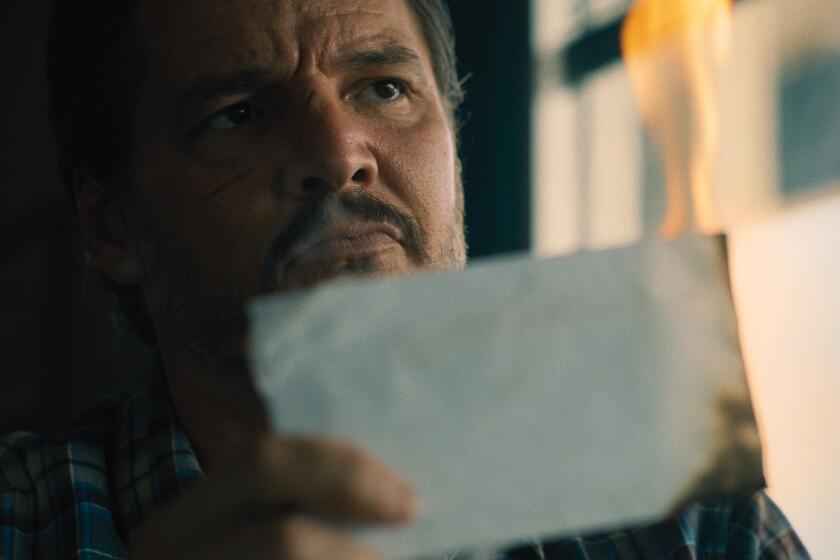‘U-571’: The Sea and the Fury
- Share via
There’s something inherently dramatic about submarines, there just is. What could be more stirring than heroic (not to mention handsome) young men under intense mental and physical stresses trapped in dangerous, claustrophobic surroundings? When you throw in those unnerving Klaxons sounding without warning and the captain screaming, “Dive! Dive! Dive!” it’s hard to go too far wrong.
Though it’s undernourished in terms of dialogue and character development (especially compared to the brilliant 1981 German “Das Boot”), “U-571,” the first World War II sub movie from Hollywood in quite a while, gets high marks for tension and excitement. The action sequences are bracing and involving and the standard plagues of submarine life (water and fire, men cracking under pressure, the fierce impact of depth charges) are played for maximum effect.
Credit that to the brisk, professional way with traditional genre material of director and co-writer Jonathan Mostow, who showed the same traits in his little-seen 1997 debut, “Breakdown.” An assured physical director, Mostow (working with “Face/Off” cinematographer Oliver Wood and a “Last of the Mohicans” editor, Wayne Wahrman) handles both the pure chaos of men firing at one another in confined spaces and the anxiety of a ship going down, down, down with welcome aplomb.
“U-571” is so old-fashioned it begins with a narrative crawl that could have come from decades-old submarine classics like “We Dive at Dawn,” “The Enemy Below” and “Run Silent, Run Deep.” It’s the spring of 1942, and Hitler’s U-boats are “wreaking havoc in the North Atlantic,” sinking ship after ship and seriously disrupting the war effort.
The film (written by Mostow, his “Breakdown” co-writer Sam Montgomery and former submarine crewman David Ayer) opens inside just such a German killing machine, the U-571 of the title. After smartly dispatching a victim, the U-boat finds itself the target of an advancing destroyer intent on revenge.
As fans of the 1950s TV series “The Silent Service” can testify, it’s those lumbering depth charges that do the most harm to a sub, and “U-571” is most in its element handling that kind of damage. An apparatus called a gimbal is used to simulate the shaking of a sub under attack, and special effects supervisor Allen Hall designed what producer Dino De Laurentiis legitimately calls “the Ferrari of gimbals,” so effective in simulating both the early attack and later ones that when someone talks about depth charges capable of knocking the fillings out of your teeth, you believe it.
Afloat but disabled, the U-571 is unknown to the men of the American sub S-33, gathered to celebrate the marriage of one of their number. The only person in a less than festive mood is Lt. Andrew Tyler (Matthew McConaughey), the ship’s executive officer, or “x.o.,” who has just been turned down in his request to be (what else but) the captain of his own ship.
Tyler is much liked by his crew and that, the S-33’s Lt. Cmdr. Mike Dahlgren (Bill Paxton) soon tells his x.o., is part of the problem. Tyler, it turns out, may be too much of a nice guy for the rigors of combat, and his commander worries that he won’t be able to make the tough decisions that could cost his men their lives, perhaps unnecessarily.
Before too much wedding celebrating can take place, the S-33’s shore leave is canceled and they are off on a “special op.” Aided by the German-speaking Lt. Hirsch (Jake Weber) and Marine Maj. Coonan (David Keith), the S-33 is going to pretend to be a German rescue ship going to the aid of U-571. Their real mission is to capture the boat’s Enigma machine, part of a German secret coding system that the Allies must decipher to have a shot at winning the war.
This is a great premise (inspired by real events, although in truth mostly accomplished by Britain’s Royal Navy), and it doesn’t take a genius at code to figure out that some seriously unforeseen things are going to happen along the way. It’s no surprise either that Tyler ends up in command situations and gets to appreciate how difficult it is to be the man in charge.
The “U-571” script is strong on structure, alternating an endless variety of crises to keep audiences off balance. The genius of “Das Boot” was clearly on everyone’s mind--a few scenes feel like quotes and that picture’s production designer, Gotz Weidner, did the honors here along with William Ladd Skinner--so it’s too bad that the filmmakers couldn’t also duplicate that picture’s sense of dramatic reality.
The physical verisimilitude that “U-571” managed with full-size replicas of World War II submarines deserts it when it comes to character and dialogue. Harvey Keitel as a veteran chief petty officer looks pained to have to say things like “I’m a sea dog, sir, I need some salt” and none of his shipmates are giants of credibility, either.
It’s McConaughey, awfully handsome in his dress whites and appropriately sweaty under the strain of combat, who comes off best. He’s a decent actor, now that he can be seen clearly after the fuss of his “A Time to Kill” performance has faded, and his heroic presence is exactly what this stalwart film is happiest falling back on.
* MPAA rating: PG-13, for war violence. Times guidelines: extremely intense scenes inside submarines under attack.
‘U-571’
Matthew McConaughey: Lt. Andrew Tyler
Bill Paxton: Lt. Cmdr. Mike Dahlgren
Harvey Keitel: Chief Klough
Jon Bon Jovi: Lt. Pete Emmett
Jake Weber: Lt. Hirsch
Erik Palladino: Mazzola
Universal Pictures and Studio Canal present, in association with Dino De Laurentiis, released by Universal Pictures. Director Jonathan Mostow. Producers Dino De Laurentiis, Martha De Laurentiis. Executive producer Hal Liebereman. Screenplay Jonathan Mostow and Sam Montgomery and David Ayer. Story Jonathan Mostow. Cinematographer Oliver Wood. Editor Wayne Wahrman. Costumes April Ferry. Music Richard Marvin. Production design Wm Ladd Skinner, Gotz Weidner. Art directors Marco Trentini, Maria Theresa Barbasso. Set decorators Bob Gould, Cinzia Sleiter. Running time: 1 hour, 56 minutes.
In general release throughout Southern California.
More to Read
Only good movies
Get the Indie Focus newsletter, Mark Olsen's weekly guide to the world of cinema.
You may occasionally receive promotional content from the Los Angeles Times.










